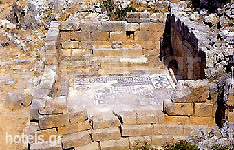Search
Hotel Name
Location
Chania Hotels, Chania Crete Island Hotel Directory

Hotel Name
Location
GreekHotels > Crete






Information About Chania Archaeological Sites

The archaeological site of Aptera is about 10 km from Souda. It was establish during the geometric period, about the 8th century BC. Its peak was during the Hellenic period with political and trading activities. The town is referred to in the Linear B tablets of Knossos as A-pa-ta-wa.
During the Roman period it became mainly an agricultural centre. It was destroyed by an earthquake during the 7th century BC. During the 12th century AD the Monastery of St John the Theologist was established there.

Ancient Lissos was an important spa town in historical times of Crete. It was destroyed in the 9th century AD and never rebuilt.
From Byzantium times onwards the area has been used for agriculture and stock breeding by the churches of Agios Kyrkou and the Virgin Mary over the royal ruins. Excavations on the site took place during the period 1957-8.

The modern city of Hania is built on the ancient town of Kydonia, listed as Ky-do-ni-ja on the Linear B tablets. Legend has it that it was one of the three towns established by King Minos.
Homer refers to the Kydonians as one of the five Cretan "tribes", but Stravonas refers to Kydonia as the 3rd largest town on Crete.
From 1966 onwards there have been continued excavations and finds are to be found in the Archaeological Museum of Hania.

A Venetian Fortress built in a rectangular form with square towers on its sides; the gate has the lion of St Mark wearing a Venetian royal crown. The interior and the battlements were built during the Turkish occupation when there were many raids.
Below the fortress are the ruins of the church of St Mark. The fortress was erected in 1371 to protect the cove from pirate attacks. Its use during the Venetian period was minor and prior to the Turkish invasion it was abandoned.
In 1828, it was destroyed and its towers left in ruins whilst in the hands of the Cretan revolutionaries.
Folklore has it that during the second 15 days in May, under certain weather conditions, black shadows appear of the Cretan revolutionaries that lost their lives there in the fight for freedom going towards the Frangokastello Fortress. Locals name these shadows as "dews".
Close to the fortress is the church of Agios Nikita built in 1371, where there are traces of old Christian relics.

Ancient Falasarnas is at the base of the western peninsula of Gramvoussa. The area was inhabited from the mid Minoan period to the 1st century BC, when the Romans sealed the entrance to its port because it was used by pirates as a base.
English archaeologists explored the town during the 19th century and found traces of the closed port. From 1986 onwards there have been systematic explorations to establish the extent of the port environs.

Exact, partial, brief, paraphrased or adapted reproduction or republication of the contents and design of this website by any means
mechanical, electronic, photocopied or otherwise without previous authorisation from the legal owner is strictly forbidden.
Copyright © 1994 - 2025 www.greekhotels.gr (KAVI CLUB S.A. - Travel Services in Greece)
Find your hotel.
Type the name, select from the list and click go.
Hotels and Apartments in Crete